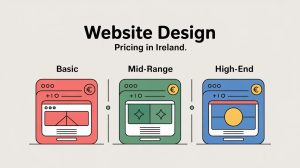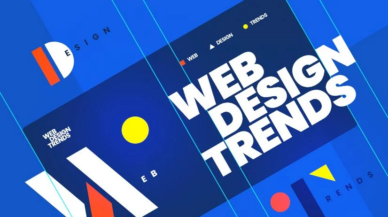In the bustling digital landscape of Dublin, having a website that stands out and effectively communicates your brand message is crucial. Whether you’re a business owner, a designer, or a marketing professional, understanding the secrets to successful website design, particularly in Dublin, is key to achieving online success. This comprehensive guide will explore the crucial elements contributing to a well-designed and high-performing website, with a specific focus on optimizing for local relevance, making it an ideal resource for anyone seeking exceptional Website Design Dublin services.
User Experience (UX):
User experience is at the forefront of successful website design. It encompasses various aspects that ensure visitors interact positively with your site.
- Intuitive Navigation: An easy-to-navigate website is essential for retaining visitors. Implement a clear and logical menu structure that guides users seamlessly through your content.
- Clear Calls to Action (CTAs): Strategically placed and well-designed CTAs prompt users to take desired actions. Ensure your CTAs are visible and compelling and guide visitors towards conversion.
- Responsive Design: With the increasing use of mobile devices, a responsive design is non-negotiable. Ensure your website adapts seamlessly to different screen sizes for a consistent user experience.
- Fast Loading Times: Users expect websites to load quickly. Optimize images, use efficient code, and leverage browser caching to minimize loading times.
Visual Design:
The visual appeal of your website plays a crucial role in capturing visitors’ attention and conveying your brand identity.
- Appealing Color Schemes: Choose a color palette that aligns with your brand and resonates with your target audience. Consistency in color usage fosters a cohesive and professional look.
- Consistent Branding: Maintain a consistent brand identity throughout your website. This includes using the same logo, fonts, and design elements across all pages.
- High-Quality Images: Invest in high-quality, relevant images that enhance your content. Blurry or pixelated images can detract from your site’s professionalism.
- Readable Typography: Choose fonts that are easily read across different devices. Pay attention to font size, line spacing, and contrast to improve readability.
Content Strategy:
Compelling content is the backbone of a successful website, influencing both user engagement and search engine rankings.
- Engaging and Relevant Content: Craft content that speaks to your target audience. Share valuable information, tell your brand story, and provide solutions to your visitors’ needs.
- Clear Messaging: Clearly communicate your brand message and value proposition. Avoid jargon and ensure that your content is easily understandable.
- SEO Optimization: Implement SEO best practices, including keyword optimization, meta tags, and a well-structured URL hierarchy, to improve your website’s visibility on search engines.
Functionality:
The functionality of your website directly impacts user satisfaction and conversion rates.
- Mobile Responsiveness: With most internet users accessing websites on mobile devices, a mobile-responsive design is essential for reaching a wider audience.
- Cross-Browser Compatibility: Ensure your website works seamlessly on different browsers to provide a consistent experience for all users.
- Forms and Interactive Elements: Implement user-friendly and interactive elements to encourage engagement. Keep forms concise and easy to fill out.
Performance Optimization:
Optimizing your website’s performance is vital for retaining visitors and ranking well on search engines.
- Efficient Code: Clean and efficient code improves loading times and website performance. Regularly optimize and update your codebase.
- Image Compression: Compress images without compromising quality to reduce page load times. This is particularly important for users with slower internet connections.
- Minimized HTTP Requests: Reduce the number of HTTP requests by combining files and using browser caching. This minimizes load times, especially for repeat visitors.
Accessibility:
Creating an inclusive online environment is not only ethical but also necessary for reaching a diverse audience.
- Compliance with Accessibility Standards (WCAG): Ensure your website complies with Web Content Accessibility Guidelines (WCAG) to make it accessible to people with disabilities.
- Alt Text for Images: Provide descriptive alt text for images to assist users with visual impairments and improve SEO.
- Keyboard Navigation: Test and optimize your website for keyboard navigation to accommodate users who rely on this feature.
Security:
Ensuring the security of your website protects both your business and your visitors.
- SSL Encryption: Secure your website with SSL encryption to protect user data and build trust.
- Regular Security Audits: Conduct regular security audits to identify and address potential vulnerabilities.
- Secure Data Handling: Implement secure data handling practices to safeguard user information.
Analytics and Measurement:
Tracking and analyzing user behaviour is essential for making informed decisions and refining your website.
- Integration with Analytics Tools: Integrate tools like Google Analytics to track user interactions, traffic sources, and other valuable metrics.
- Conversion Tracking: Set up conversion tracking to monitor the effectiveness of your CTAs and optimize for better conversion rates.
- User Behavior Analysis: Analyze user behavior to understand how visitors interact with your website and make data-driven improvements.
Update and Maintenance:
Regular updates and maintenance are crucial for keeping your website secure, functional, and aligned with your business goals.
- Regular Updates: Keep your website’s CMS, plugins, and themes up to date to benefit from the latest features and security patches.
- Backup Systems: Implement regular backup systems to protect against data loss and potential disruptions.
- Monitoring and Troubleshooting: Set up monitoring tools to identify issues promptly and troubleshoot any problems that may arise.
Client Collaboration:
Effective communication and collaboration with clients ensure that your website aligns with their goals and expectations.
- Clear Communication: Maintain open and clear communication channels with your clients throughout the design and development process.
- Understanding Client Goals: Gain a deep understanding of your client’s goals, target audience, and overall vision for the website.
- Feedback and Iteration: Encourage client feedback and be willing to iterate on design elements based on their input.
Conclusion:
Achieving successful website design in Dublin requires a holistic approach encompassing user experience, visual design, content strategy, functionality, performance optimization, accessibility, security, analytics, and client collaboration. By integrating these essential elements into your web design process, you’ll not only create a visually appealing website but also one that delivers a seamless and enjoyable experience for your visitors. Stay updated, monitor performance, and continuously refine your website to stay ahead in the dynamic online landscape.



































































































































